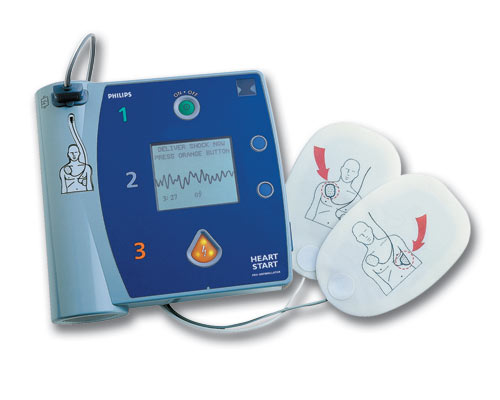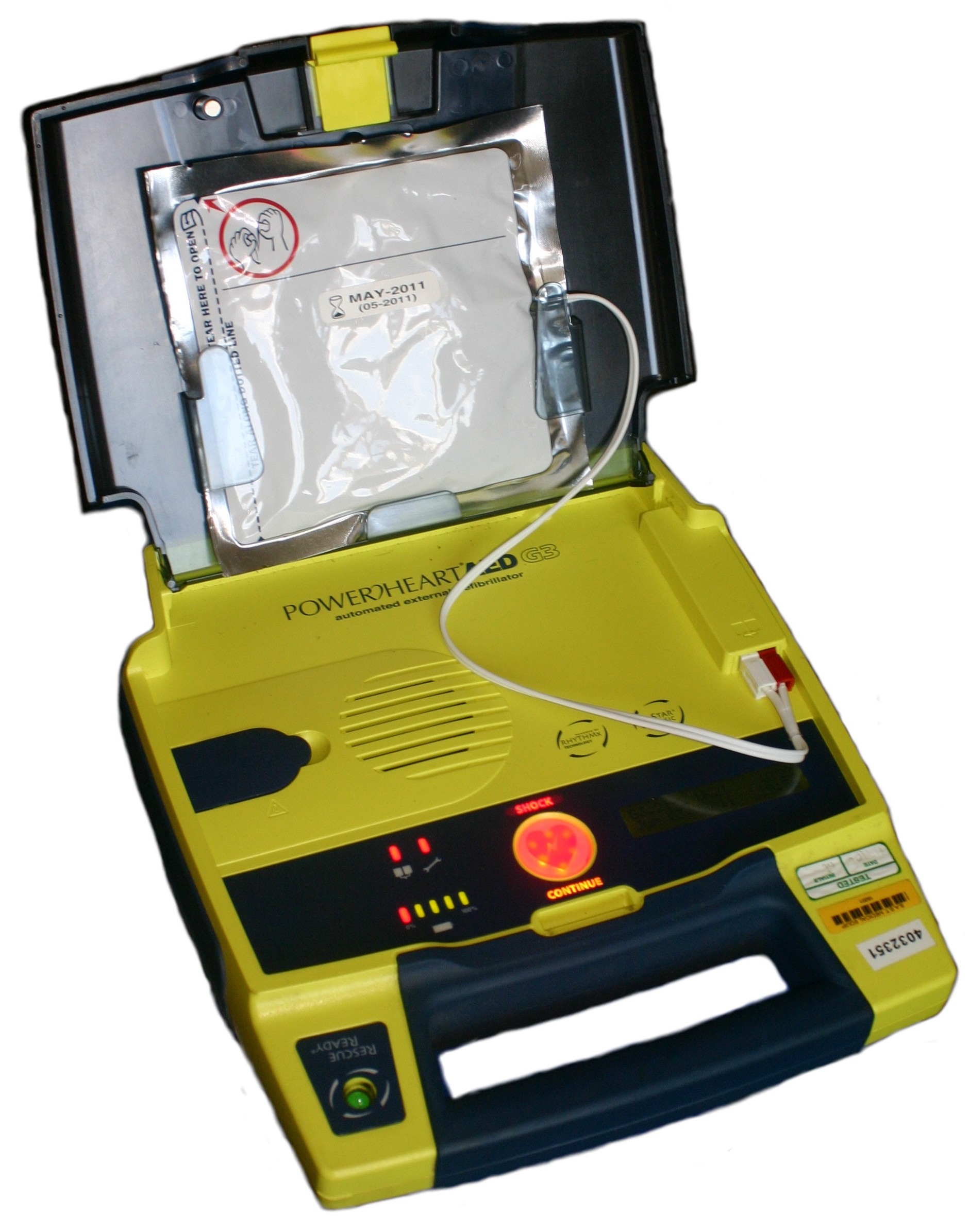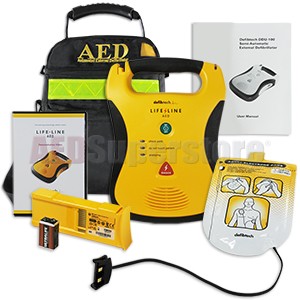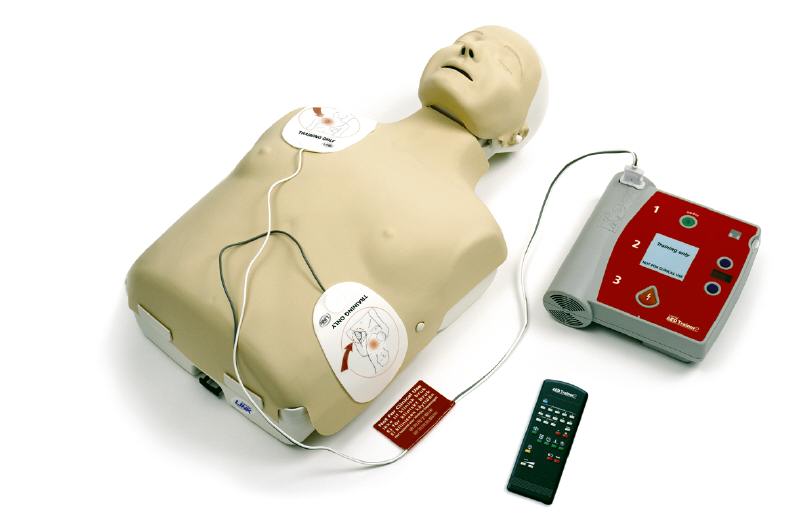Automated external defibrillator
An Automated External Defibrillator ( AED ugs lay defibrillator or defibrillator ) is a medical device for the treatment of shockable cardiac arrhythmia by delivering electric shocks. Unlike defibrillators in the emergency medical services or clinics AEDs are suitable due to their construction and operation especially for lay persons.
- 3.1 Germany
- 3.2 Other countries in Europe
Application, design and function
The two adhesive electrodes, also paddles or Fast-Patch called, are attached anterolateral in adolescents and adults under the right clavicle and under the left armpit in the so-called anterior-anterior position. After applying the adhesive electrodes software analyzes the heart rhythm in AED. If ventricular fibrillation, a ventricular tachycardia and also recognized a supraventricular tachycardia in some AEDs is unlocked defibrillation / cardioversion. A fundamental distinction is fully automatic semi-automatic AEDs. In the fully automatic design, the device is the electric shock under constant surveillance from the shock conditions independently, while in the semi-automatic construction of the user, the Shock button to press within a defined interval, and thus also has the responsibility for compliance with the Schockvorausetzungen. If a non- shockable rhythm is detected or are the measured values under the device-specific Asystoliegrenzen, defibrillation is not woks. Every 2 minutes there is a statement, not to touch the patient to a new ECG analysis and may to enable a new shock.
Some AED models support the first responders at the required cardiopulmonary resuscitation, but the very uneven. Meanwhile AEDs on the market, ( eg solid press, press faster, press slowly, completely relieve ) the quality of chest compressions by voice prompts for improvement via voice and text instructions.
There are also variants of the semi-professional use with an ECG presentation and a manual Defibrillationsmöglichkeit and / or with an integrated pulse oximeter. These devices often carry a "PRO" for " professional" in their name.
Specificities of children and infants
Not all AEDs are approved for use in children under 8 years. For some of the approved AEDs, there are clearly small pediatric defibrillation. These will automatically be usually detected by the device and lowered the energy delivery for defibrillation accordingly. A variant of other AEDs is to convert by pressing a slider or plugging in a special children's key in the child mode. In this case one uses the existing electrodes and stick the to the chest and on the back - the so-called anterior-posterior position so as to avoid contact of the two electrodes.
Dissemination
Since the chance of survival of those affected with every minute that passes without defibrillation, decreases by about 10 %, the therapy-free interval should be shortened to the care of cardiac patients by emergency medical services and emergency by early defibrillation. Therefore, since 2001, all advertise reputable charities for the use of AEDs in the public environment. So there are now a large number of heterogeneous island projects with partially publicly accessible AED. This used as a Public Access Defibrillator ( PAD ) Public AED can be found for example in airports, railway stations, football stadiums and other public buildings. In most cases the AED are placed at the entrance of buildings or in the Infirmary.
In America AED are already widespread, but also in Europe a tendency for the implementation of AEDs can be seen. In Germany AEDs are ( for example, in the state parliament of North Rhine -Westphalia, in the land registry offices in Rhineland -Palatinate ) is present in an increasing number of companies, but also in public places, for example in the stops of the Munich subway, at major airports and in public institutions.
To teach conformity with the directive have all the training organizations agreed that since 2011 in every first aid course and an AED is presented. The tendency to regular training on AEDs is more pronounced observed in the industrial countries neighboring Germany such as Belgium, Denmark, France, Luxembourg, Netherlands, Switzerland and Austria.
Legal situation
Germany
The use of an automated external defibrillator (AED) by lay people as part of the first aid is unobjectionable. Basically, an AED is an active medical device, ie for the organization in the context of occupational first aid, the Medical Devices Act ( MPG) and the Medical Devices Operator Ordinance are (MPBetreibV ) prevail. It is 1 ) to keep a medical book, it may 2 ), only the manufacturer or authorized persons from this the AED on site in operation and it needs 3 ) a device named officer in the company and trained in the expert mode of the device are. This device Commissioner may then instruct the other operating personnel. In practice, however, the initial training mostly takes place in a framework umfänglicheren for as many occupational first-aiders. In an emergency - ie in justifiable emergency ( § 34 StGB) - an AED may also be used by non- qualified personnel. In practice, however, very few first responders dare to seize this opportunity without exercise.
AEDs are not subject, therefore sometimes hard to find. It is recommended that a signs analogous to the fire extinguishers. For AED owners whose employees are insured with the professional associations, an annual training requirement applies.
Other countries in Europe
- Belgium: The Royal Decision of April 21, 2007 regulates the use of automated external defibrillators for category 1 and 2 AEDs in category 1 must of professionals and of every citizen are used.
- France: The Decree n ° 2007-705 of 4 May 2007 allows anyone, even non- physicians to operate an AED.
- UK: In the UK, the use of the AED is also regulated by law. More than 600 defibrillators hang on popular public places.
- Luxembourg: Since 19 November 2008, the use of an AED is regulated by law. AEDs are now allowed to be installed in public buildings and public places, and be used by anyone.
- Monaco: In the principality over 80 defibrillators in public places are available for use.
- Netherlands: Every human is it to use an AED.









